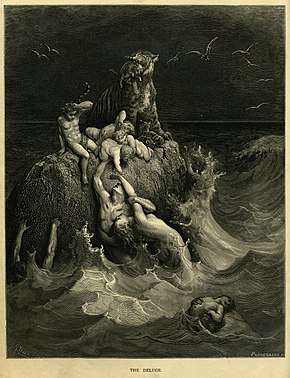The Prophet's Song
"The Prophet's Song" is a song by the British rock band Queen, originally released on their fourth studio album A Night at the Opera in 1975.
| "The Prophet's Song" | |
|---|---|
| Song by Queen | |
| from the album A Night at the Opera | |
| Released | 21 November 1975 |
| Recorded | 1975 |
| Studio | Sarm East, London |
| Genre | |
| Length | 8:21 |
| Label | EMI |
| Songwriter(s) | Brian May |
| Producer(s) |
|
Background

"The Prophet's Song" was composed by Brian May (working title "People of the Earth"). On the show In the Studio with Redbeard, which spotlighted A Night at the Opera, he explained that he wrote the song after a dream he had about a great flood while he was recovering from being ill while recording Sheer Heart Attack, and is the source of some of the lyrics. Portions of the song were recorded but abandoned during sessions for Queen II.[2]
May spent several days putting it together, and it includes a vocal canon sung by Freddie Mercury. The vocal, and later instrumental canon was produced by early tape delay devices. It is a heavy and dark number with a strong progressive rock influence and challenging lead vocals. At over eight minutes in length, it is also Queen's longest song with vocals, though the untitled instrumental track from Queen's last studio album, Made in Heaven, is about 14 minutes longer. May also admitted the guitar's lowest E2 string is tuned down to a D2 note, a rarity at the time.[3]
May plays a non-standard Queen instrument, a toy koto, during the introduction and closing "wind" sections of the song. Producer Roy Thomas Baker recalled in a documentary[4] of the making of the song that the wind effect was created by recording the sound of an air-conditioning unit through a phaser.[3]
As detailed by May in a documentary about the album, the speed-up effect that happens in the middle of the guitar solo was achieved by starting a reel-to-reel player with the tape on it, as the original tape player was stopped.
The lyric refers to the Book of Genesis, explicitly in examples such as "return like the white dove" (a reference to the story of Noah's Ark), and cryptically in examples such as a vision of a "moonlit stair" comparable to Jacob's Ladder.
Reception
AllMusic has called the song "mystical prog rock",[5] citing it as an epic as fascinating as "Bohemian Rhapsody" and one of Queen's finest studio achievements.[6] Rolling Stone also praised it, naming it as the record's "best track", noting that "May's powerful guitar perfectly complements the rich, multitracked harmonies of lead singer Freddie Mercury."[7] Ultimate Classic Rock has also called the song "epic and mystical art rock".[8]
Personnel
Information is taken from the album’s Liner Notes[9] and the Queen Songs website[10]
- Freddie Mercury - lead and backing vocals
- Brian May - toy koto, acoustic guitar, electric guitar, backing vocals
- Roger Taylor - drums, backing vocals
- John Deacon - bass guitar
References
- "The 50 best Queen songs of all time". Classic Rock Magazine. 20 November 2018. Retrieved 23 July 2019.
- Georg Purvis. “Queen: Complete Works.' Titan Books. ISBN 9781789090499
- Making Of The Prophets Song, retrieved 30 January 2020
- Longfellow, Matthew. "Queen: The Making of A Night at the Opera". Making of The Prophet's Song. Eagle Rock Entertainment. Retrieved 24 November 2018.
- Erlewine, Stephen Thomas. "A Night at the Opera". AllMusic. Retrieved 25 August 2015.
- Guarisco, Donald A. "The Prophet's Song". AllMusic. Retrieved 25 August 2015.
- "A Night At The Opera". Rolling Stone.
- Rivadavia, Eduardo (21 November 2015). "Revisiting Queen's Masterpiece, 'A Night at the Opera'". Ultimate Classic Rock. Retrieved 1 February 2019.
- A Night at the Opera (Media notes). EMI Records. 1975. EMTC 103.
- "Archived copy". Archived from the original on 13 June 2018. Retrieved 27 December 2018.CS1 maint: archived copy as title (link)